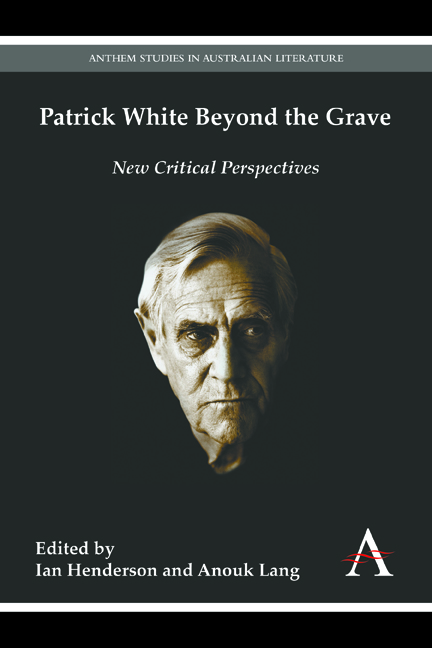Book contents
- Frontmatter
- Contents
- Acknowledgements
- Introduction
- Part I RESURRECTED PAPERS
- Part II MANY IN ONE
- Part III THE PERFORMANCE OF READING
- Chapter 7 Patrick White's Expressionism
- Chapter 8 The Doubling of Reality in Patrick White's The Aunt's Story and Paul Schreber's Memoirs of My Nervous Illness
- Chapter 9 Desperate, Marvellous Shuttling: White's Ambivalent Modernism
- Chapter 10 ‘Time and Its Fellow Conspirator Space’: Patrick White's A Fringe of Leaves
- Part IV QUEER WHITE
- Contributors
- Index
Chapter 8 - The Doubling of Reality in Patrick White's The Aunt's Story and Paul Schreber's Memoirs of My Nervous Illness
from Part III - THE PERFORMANCE OF READING
Published online by Cambridge University Press: 18 January 2018
- Frontmatter
- Contents
- Acknowledgements
- Introduction
- Part I RESURRECTED PAPERS
- Part II MANY IN ONE
- Part III THE PERFORMANCE OF READING
- Chapter 7 Patrick White's Expressionism
- Chapter 8 The Doubling of Reality in Patrick White's The Aunt's Story and Paul Schreber's Memoirs of My Nervous Illness
- Chapter 9 Desperate, Marvellous Shuttling: White's Ambivalent Modernism
- Chapter 10 ‘Time and Its Fellow Conspirator Space’: Patrick White's A Fringe of Leaves
- Part IV QUEER WHITE
- Contributors
- Index
Summary
Introduction
This chapter reads two accounts of madness from different discursive fields alongside one another. It looks at how these accounts – one from a fictional text, The Aunt's Story (1948) by Patrick White, and the other from a memoir, Paul Schreber's Memoirs of My Nervous Illness (1903) – share common features. I wish to show how a comparison of these texts can help us understand three key aspects of White's style in this novel: the erasure of narrative presence, the mixing of narrative viewpoints and the doubling of narration in which two points of view co-exist.
Many critics have noted the transitional place The Aunt's Story occupies in White's oeuvre, seeing it as resting on the cusp of a change from early to late styles. They note its heightened poetic language, which stems in part from a successful assimilation of modernist precursors, and a more experimental use of syntax. In this third novel, they consider White as reaching a high point in purely stylistic terms, one from which he retreats in subsequent works. The Aunt's Story also stands at the pivot of many personal transitions: in it White pays homage to Europe while embarking for home and Australia. He also turns away from a life of multiple relationships to a single, settled love. In a larger sense then love and home are what are at stake behind the stylistic innovations. That the narrative strives for, and often achieves, the texture of madness is a measure of White's skill and personal daring. I would like to suggest that further investigations into White's psychobiography, tracing his experience and fears of madness, would yield new pathways into his work. This chapter will, however, concentrate on stylistic effects. These recreate encounters with radical, altered states while debating the issue of sanity. Reading these stylistic effects against those used in Paul Schreber's memoirs points to many useful similarities; in a final analysis, however, fictional and discursively normative representations of madness show major divergence.
- Type
- Chapter
- Information
- Patrick White Beyond the GraveNew Critical Perspectives, pp. 141 - 154Publisher: Anthem PressPrint publication year: 2015

